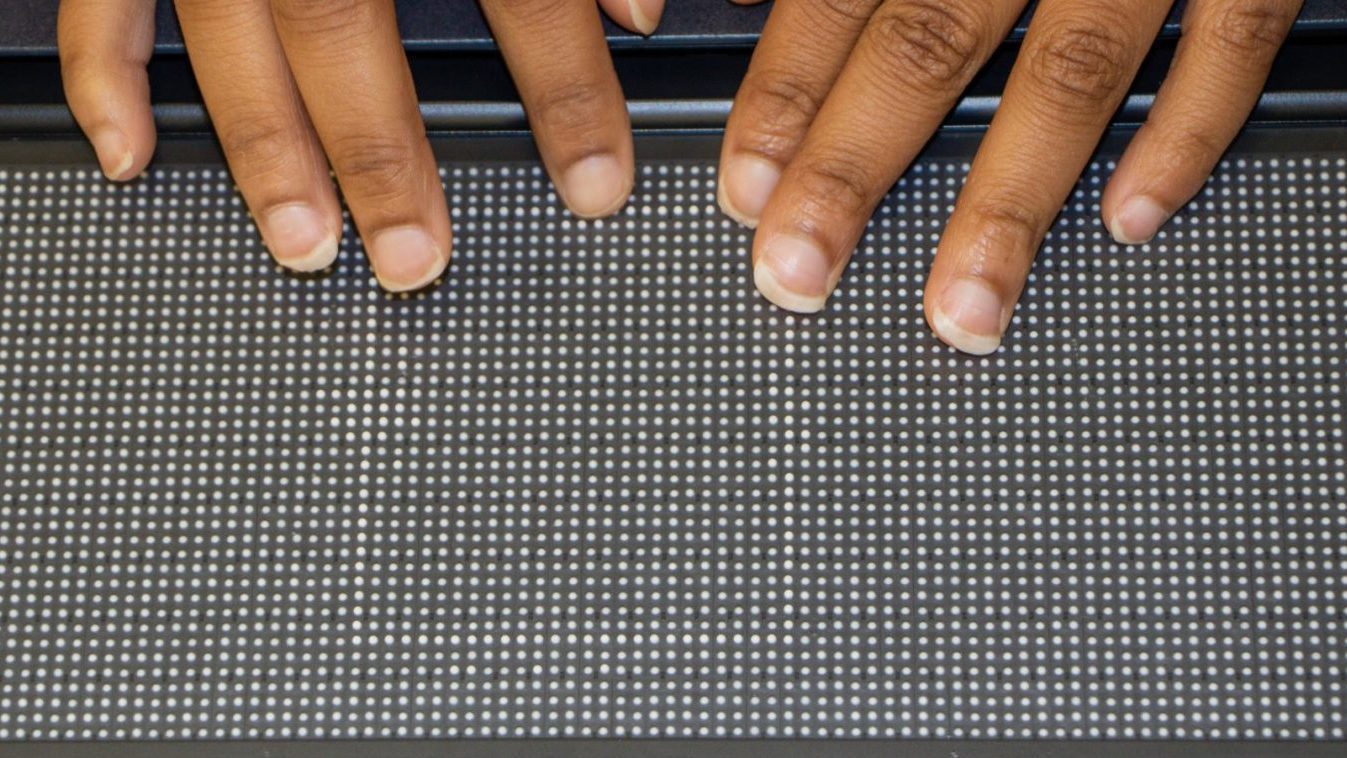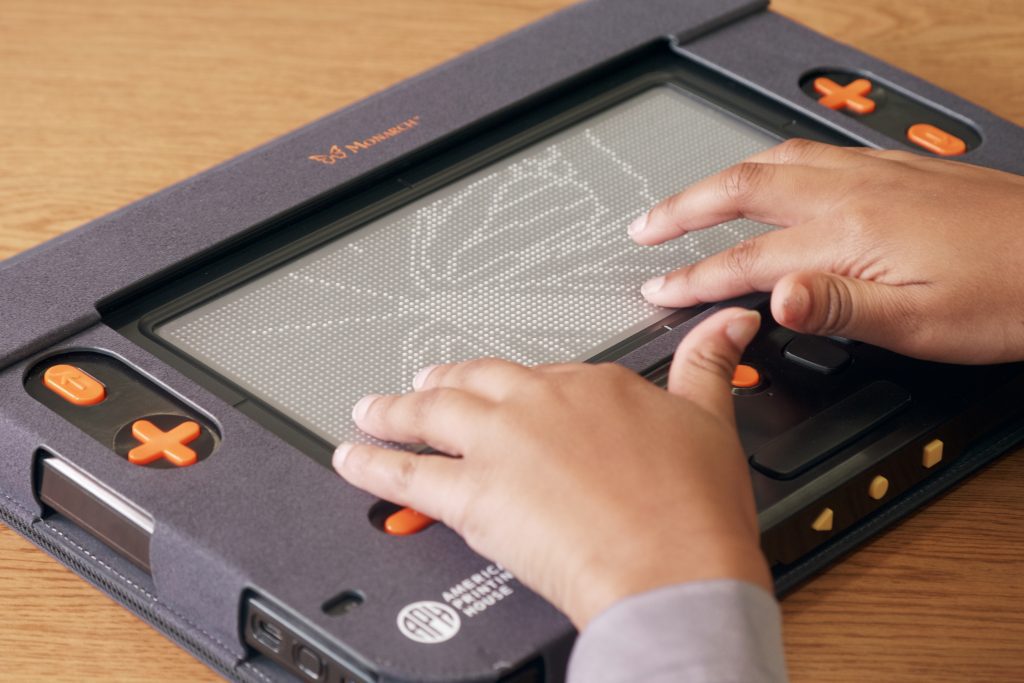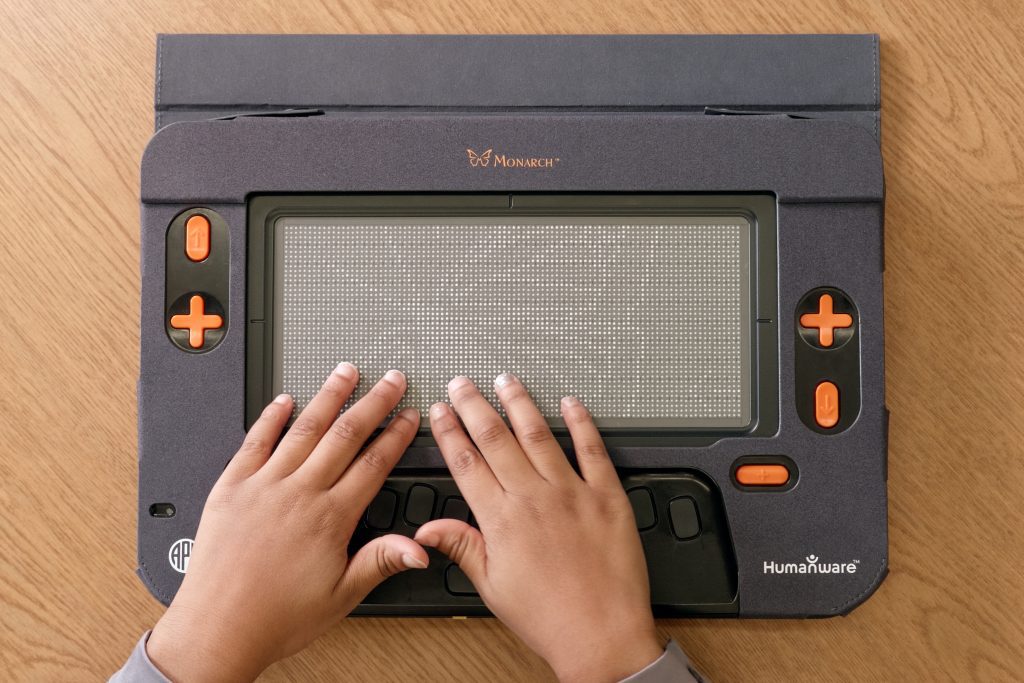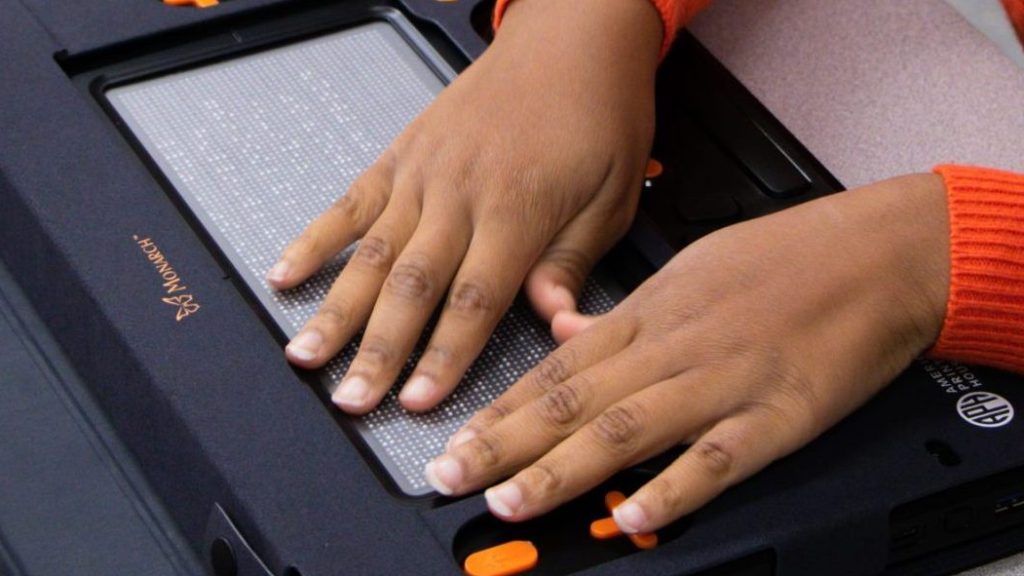Please be advised USPS is experiencing unusually long delays for Free Matter For The Blind shipping. If you have not received an order placed more than 30 days prior, please contact the APH Customer Service team at support@aph.org or 1-800-223-1839.
CloseThe Next Stop on the Holy Braille Highway: 2022 and Beyond

As 2022 comes to an end, we’re taking a look back at the exciting developments and milestones that were accomplished on the DTD project this year and giving you a preview of what’s to come as we travel on the “Holy Braille Highway” in 2023. We talked with Anne Durham, APH’s Vice President of Innovation and Strategy, and Greg Stilson, APH’s Head of Global Technology Innovation, about the progress made on this groundbreaking technology.
What is the DTD?
The Dynamic Tactile Device, or DTD, is the working name for APH’s next refreshable braille display. Stay tuned, we’re releasing more information, including the name, in early 2023!
Our number one goal is to change the way that textbooks, or content in general, is received by students. Today there can be a significant delay between the time that a textbook is ordered, and when a student actually has access to the embossed braille textbook. This puts students who are braille readers at a huge disadvantage compared to their peers. The DTD will allow textbooks to be delivered directly to the device without going through the lengthy process of embossing volumes and volumes of hard copy braille. The DTD, which will consist of 10 lines of 32 cells of standard braille, is also capable of producing multiple lines of braille and tactile graphics on the same surface, providing access to the same information in a similar fashion as their sighted classmates. The DTD will weigh approximately 4.5 pounds and is the size of a gaming laptop, allowing students to easily carry the device with them throughout their day.
We’re looking at a metamorphosis of braille and tactile graphics. This idea has been considered as the “Holy Grail” of Braille. Everyone has wanted to see multi-line braille and tactile graphics on the same surface. It’s been a dream for decades and it’s about to become a reality.
It Takes a Village
This is not the first attempt at what we refer to in our field as the “Holy Braille Project.” There have been several organizations within the industry that have tried to do this. What makes this effort unique is the partnership behind it. The specialized technology and skills brought by HumanWare, an international leader in access technology, ensure that the mechanics, hardware, and software will be world-class. Beyond the technology, we knew we needed to make sure this device truly met the needs of the people it was meant to serve. Our partnership with the National Federation of the Blind (NFB) ensures we’re making the right decisions along the way. Through the support of NFB, we can be sure we are truly following the motto “nothing about us, without us.” This must be a device that is powered by the people who are going to use it.
The eBRF
While the technology and research behind the DTD is a game-changing advancement on its own, we recognized that this powerful device alone would not be enough to make our dream of instant and efficient access to braille a reality without the file types to support it. The asphalt that makes up the Holy Braille Highway is our eBRF initiative, that, with the support of the esteemed DAISY Consortium, will expedite the transcription process while giving end users dynamic, navigable braille content like the world has never seen before.
The Impact of Access
There was some understandable skepticism when our initiatives first started. But through demonstrations, showing users how braille and tactile graphics can exist together, changing under their fingertips, we’ve seen just a preview of the impact this device will have. From joy to breaking out in laughter, astonishment, and even tears, what drives this project is the human element.
Some of the most impactful feedback has been from teachers. This will change the game when it comes to creating impromptu learning opportunities in the classroom. Also, we discovered teachers typically only teach roughly 50 tactile graphics to a student over the course of a year, and now they will have a device where a student has access to tens of thousands of tactile graphics. The other ways in which this will impact learning are yet unknown and that is truly exciting.
The Road Ahead: 2023 and Beyond
Using our first Alpha prototype, we are currently holding demonstrations and receiving user feedback in the field. The eBRF committee will continue to meet in a parallel manner to the development of the device. We will be contracting with the DAISY Consortium next year to make this eBRF dream a reality, at the same time, we will be building a BRF to eBRF converter tool so that all those existing braille files can be converted to eBRF. Also, we are ordering parts and trying to get ahead of supply chain challenges to ensure our Beta units come in on time. We are hopeful that the first Beta units will start coming in during the spring of 2023, they will then be field tested in various education systems throughout the year.
A good highway gives you directions, so directions will be in the form of extensive trainings, learning programs, and materials for teachers and users. Rolling into 2024, we will be heavily focused on training teachers on the new concepts introduced by a device like this. Concepts such as zooming in and out of graphics, panning around a tactile image, multi-line electronic braille navigation and so much more. Our hope is to have this device available by the end of 2024.
A good highway also gives you connections. That’s going to be a learning community of users, software developers, educators, professionals, and parents; we’re all trailblazers in this instance and we must learn from each other. That’s making sure there is an international network of tech support, cross-platform access to all the information and resources people need, and access to all kinds of robust and dynamic content, which we will be opening to other software developers through an SDK kit so that they can develop other apps for the device.
Finally, a good highway gives you navigation. The only way we are going to be able to navigate this highway is if we have global advocacy support for access and affordability. We need standards for electronic, dynamic tactile graphics since something like this has never existed before. Also, laws and funding so that this device can be used in public education and employment. These things are important, not just for this product, but for the future of electronic braille access for all.
Be “In the Know”
Sign up to receive the latest updates about the DTD and eBRF projects. Input your email address, make sure “Subscribe” is selected in the dropdown menu, and then select “Next.” You should receive an email asking you to confirm your email address.
Share this article.
Related articles

Mastering the Monarch
The braille metamorphosis has begun! More than 40 teachers from across the U.S. are gathering in Orlando, FL prior to...

Monarch Field Testing Reaches Halfway Point
Friday, November 3rd marked the halfway point for Monarch Field Testing. Composed of three, two-week units of course content, the...

The eBRF Revolution
As you may have heard, we are working on two game-changing projects that, together, will alter the way we access...
